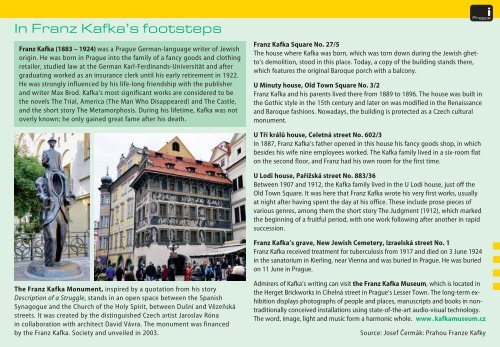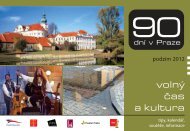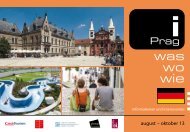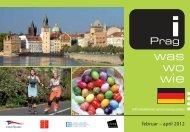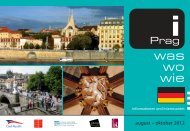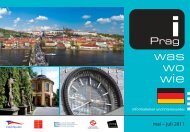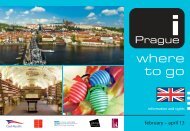where to go - i-Prague
where to go - i-Prague
where to go - i-Prague
Create successful ePaper yourself
Turn your PDF publications into a flip-book with our unique Google optimized e-Paper software.
In Franz Kafka’s footsteps<br />
Franz Kafka (1883 – 1924) was a <strong>Prague</strong> German-language writer of Jewish<br />
origin. He was born in <strong>Prague</strong> in<strong>to</strong> the family of a fancy <strong>go</strong>ods and clothing<br />
retailer, studied law at the German Karl-Ferdinands-Universität and after<br />
graduating worked as an insurance clerk until his early retirement in 1922.<br />
He was strongly influenced by his life-long friendship with the publisher<br />
and writer Max Brod. Kafka’s most significant works are considered <strong>to</strong> be<br />
the novels The Trial, America (The Man Who Disappeared) and The Castle,<br />
and the short s<strong>to</strong>ry The Metamorphosis. During his lifetime, Kafka was not<br />
overly known; he only gained great fame after his death.<br />
Franz Kafka Square No. 27/5<br />
The house <strong>where</strong> Kafka was born, which was <strong>to</strong>rn down during the Jewish ghet<strong>to</strong>’s<br />
demolition, s<strong>to</strong>od in this place. Today, a copy of the building stands there,<br />
which features the original Baroque porch with a balcony.<br />
i<br />
<strong>Prague</strong><br />
U Minuty house, Old Town Square No. 3/2<br />
Franz Kafka and his parents lived there from 1889 <strong>to</strong> 1896. The house was built in<br />
the Gothic style in the 15th century and later on was modified in the Renaissance<br />
and Baroque fashions. Nowadays, the building is protected as a Czech cultural<br />
monument.<br />
U Tří králů house, Celetná street No. 602/3<br />
In 1887, Franz Kafka’s father opened in this house his fancy <strong>go</strong>ods shop, in which<br />
besides his wife nine employees worked. The Kafka family lived in a six-room flat<br />
on the second floor, and Franz had his own room for the first time.<br />
U Lodi house, Pařížská street No. 883/36<br />
Between 1907 and 1912, the Kafka family lived in the U Lodi house, just off the<br />
Old Town Square. It was here that Franz Kafka wrote his very first works, usually<br />
at night after having spent the day at his office. These include prose pieces of<br />
various genres, among them the short s<strong>to</strong>ry The Judgment (1912), which marked<br />
the beginning of a fruitful period, with one work following after another in rapid<br />
succession.<br />
Franz Kafka’s grave, New Jewish Cemetery, Izraelská street No. 1<br />
Franz Kafka received treatment for tuberculosis from 1917 and died on 3 June 1924<br />
in the sana<strong>to</strong>rium in Kierling, near Vienna and was buried in <strong>Prague</strong>. He was buried<br />
on 11 June in <strong>Prague</strong>.<br />
The Franz Kafka Monument, inspired by a quotation from his s<strong>to</strong>ry<br />
Description of a Struggle, stands in an open space between the Spanish<br />
Syna<strong>go</strong>gue and the Church of the Holy Spirit, between Dušní and Vězeňská<br />
streets. It was created by the distinguished Czech artist Jaroslav Róna<br />
in collaboration with architect David Vávra. The monument was financed<br />
by the Franz Kafka. Society and unveiled in 2003.<br />
Admirers of Kafka’s writing can visit the Franz Kafka Museum, which is located in<br />
the Herget Brickworks in Cihelná street in <strong>Prague</strong>’s Lesser Town. The long-term exhibition<br />
displays pho<strong>to</strong>graphs of people and places, manuscripts and books in nontraditionally<br />
conceived installations using state-of-the-art audio-visual technology.<br />
The word, image, light and music form a harmonic whole. www . kafkamuseum.cz<br />
Source: Josef Čermák: Prahou Franze Kafky


